LAWS OF THE UNIVERSE (3)
By:
August 27, 2017
One in a series of ten posts reprinting installments of HILOBROW friend Chris Spurgeon’s LAWS OF THE UNIVERSE, a newsletter celebrating the rules, constants, principles, theorems, effects “shining a tiny bit of light onto one tiny bit of how the universe operates.”
The bands of color that appear when light waves reflect from two closely adjacent surfaces.
Back in 1803 my main man, William Blake wrote…
To see a World in a Grain of Sand
And a Heaven in a Wild Flower
Hold Infinity in the palm of your hand
And Eternity in an hour(*)
If he had been born a century or two later, after automobiles were common, I wonder if he would have had an additional line in there about being able to see a rainbow in a puddle…
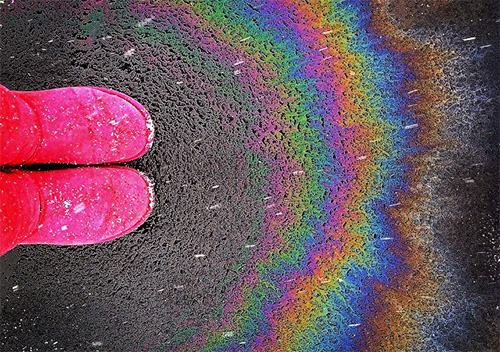
We’ve all seen a puddle with a drop of oil or gasoline in it turn into a vivid display of rainbow colors. Or we’ve all seen a soap bubble turn into a panoply of colors shortly before popping…
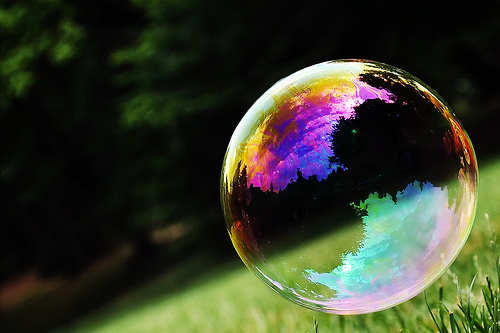
Both of these are examples of an optical phenomenon known as thin-film interference. Light striking the puddle or bubble gets split. Part of it reflects off of the upper surface of the oil or bubble, while the rest reflects off of the bottom surface of the oil (where it meets the water) or off of the inner surface of the bubble.(**). These two portions of light travel slightly different distances, which can affect how they interact when they recombine. Let’s imagine beams of red light striking a soap bubble…
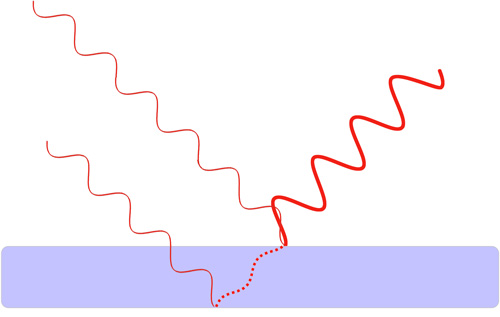
This soap bubble is just the right thickness so that when the two light beams recombine after reflection they’re in perfect sync with each other, and red light will strongly reflect back. But now let’s consider green light hitting the exact same spot of the soap bubble…
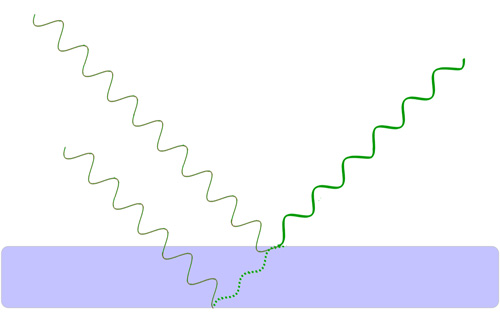
Green light has a different wavelength than red, and in this example the recombined light waves are out of sync with each other, and cancel each other out. As a result, very little green light is reflected back.
The most minute variations in thickness of the oil or soap determine which colors reflect back and which colors get absorbed. A variation of a few nanometers can be the difference between seeing a patch of red or a patch of blue.(***)
You can see a similar effect when you place a slightly curved piece of glass on top of another piece of glass that’s flat. In this case, part of the light is reflecting off of the bottom of the curved glass, while part is reflecting off of the upper surface of the flat piece of glass beneath it.
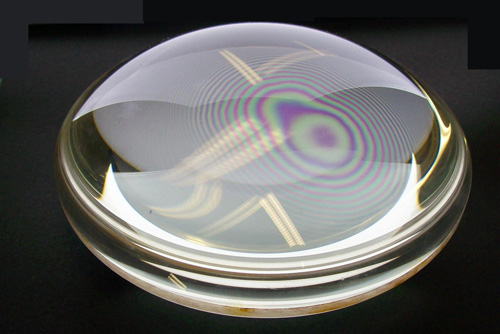
This arrangement generates a pattern of colored circles known as Newton’s rings, named for Sir Isaac Newton, who first investigated the effect in 1717.(****)
Since the most minute differences in shape and distance can cause changes in these light patterns, Newton’s rings are used in many industries and fields of science to take ultra-precise measurements.
The mechanism behind Newton’s rings shows up in other places as well. It’s what causes steel to change color when it’s heated. In this case light is bouncing off of the top and bottom surfaces of a very thin layer of iron oxide.

The thickness of that iron oxide layer varies depending on how the metal is heated and cooled. Metalworkers for hundreds, if not thousands, of years have used those color variations as a reliable indicator of the degree of tempering of the metal. It also causes the iridescent colors in the feathers of birds, such as the European Starling.

Isaac Newton (1642-1726) was one of the most brilliant people who ever lived. Every one of these Laws of the Universe essays highlights someone of extraordinary intellect and insight. But Newton, well, he’s just on a whole other level. He discovered the universal laws of motion, he discovered the law of gravity, he invented calculus, and he laid out the principles of modern optics and color. That’s just the top of his resume; most people don’t know that he also invented the reflecting telescope, formulated the first empirical law of heating and cooling, made the first calculation of the speed of sound, improved the mathematics of binomial coefficients, was president of the Royal Society, and ran the Royal Mint for more than 30 years.
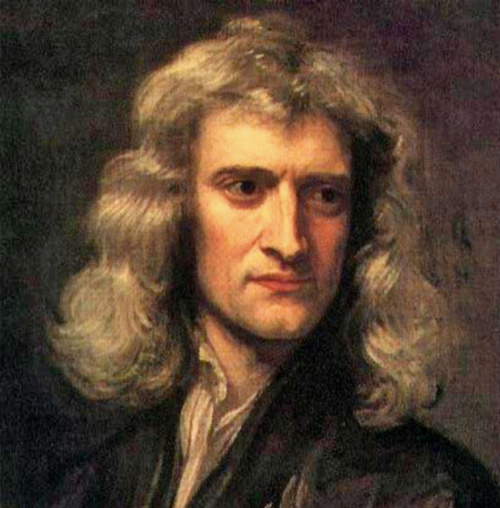
By all accounts Newton had an unhappy childhood. His father died before he was born. When he was three his mother remarried and palmed young Isaac off on his grandmother. He grew up in sight of his mother’s house without being allowed to be part of it.
He was brilliant even a a child, and at the age of 19 was admitted to Trinity College at the University of Cambridge. He would eventually be named the Lucasian Professor of Mathematics at Cambridge, one of the most prestigious positions in the math world. Later holders of the post would include Charles Babbage and Stephen Hawking.
In spite of — perhaps because of — his extraordinary genius, Newton was genuinely weird. He was chronically absent-minded and easily distracted. He spent his later years in such pursuits as trying to turn base metals into gold (*****), and studying the floor-plan of King Solomon’s temple in Jerusalem (in the belief that its geometry held clues to the date of the second coming of Christ). He was also, possibly, a secret member of a religious group that disputed the Christian doctrine of the holy trinity. (Given that he was on the faculty of a place called Trinity College, it’s not surprising that he would have kept that on the down low.) The general consensus is that he died a virgin.
The story about Isaac Newton I’m most fond of is from his time at Cambridge. As the story goes, when Newton was walking between buildings on campus he would sometimes pause, scratch some esoteric diagram or equation into the dirt with his cane, ponder it for a while, and then walk on. Students and faculty who would come across these markings would take care to walk around them, in case Professor Newton needed to refer to them later. The drawings would remain undisturbed until the next rain washed them away. If I had been a student there, I would have guarded those scratchings with my life.
(*) Auguries of Innocence
(**) An additional portion of the light doesn’t reflect off of either surface, it just passes through. That portion has no effect on this phenomenon.
(***) A typical soap bubble is between 10 and 1000 nanometers thick. In comparison, a typical human hair is about 50,000 nanometers thick.
(****) It turns out Newton was not the first scientist to write about this effect. Robert Hooke mentioned it a half century before, in his book Micrographia. But it was Newton who first explained the mechanism of the phenomenon. This is a pattern that happened repeatedly throughout Hooke and Newton’s lives… Hooke would claim some discovery because he had mentioned it first, but Newton would claim the discovery was his because he actually figured out the underlying science. If you’ve read my essay on Hooke’s Law then you already know how much Hooke and Newton hated each other. Newton’s rings probably didn’t help matters.
(*****) If Lavoisier was the first great chemist, Newton was the last great alchemist.
CURATED SERIES at HILOBROW: UNBORED CANON by Josh Glenn | CARPE PHALLUM by Patrick Cates | MS. K by Heather Kasunick | HERE BE MONSTERS by Mister Reusch | DOWNTOWNE by Bradley Peterson | #FX by Michael Lewy | PINNED PANELS by Zack Smith | TANK UP by Tony Leone | OUTBOUND TO MONTEVIDEO by Mimi Lipson | TAKING LIBERTIES by Douglas Wolk | STERANKOISMS by Douglas Wolk | MARVEL vs. MUSEUM by Douglas Wolk | NEVER BEGIN TO SING by Damon Krukowski | WTC WTF by Douglas Wolk | COOLING OFF THE COMMOTION by Chenjerai Kumanyika | THAT’S GREAT MARVEL by Douglas Wolk | LAWS OF THE UNIVERSE by Chris Spurgeon | IMAGINARY FRIENDS by Alexandra Molotkow | UNFLOWN by Jacob Covey | ADEQUATED by Franklin Bruno | QUALITY JOE by Joe Alterio | CHICKEN LIT by Lisa Jane Persky | PINAKOTHEK by Luc Sante | ALL MY STARS by Joanne McNeil | BIGFOOT ISLAND by Michael Lewy | NOT OF THIS EARTH by Michael Lewy | ANIMAL MAGNETISM by Colin Dickey | KEEPERS by Steph Burt | AMERICA OBSCURA by Andrew Hultkrans | HEATHCLIFF, FOR WHY? by Brandi Brown | DAILY DRUMPF by Rick Pinchera | BEDROOM AIRPORT by “Parson Edwards” | INTO THE VOID by Charlie Jane Anders | WE REABSORB & ENLIVEN by Matthew Battles | BRAINIAC by Joshua Glenn | COMICALLY VINTAGE by Comically Vintage | BLDGBLOG by Geoff Manaugh | WINDS OF MAGIC by James Parker | MUSEUM OF FEMORIBILIA by Lynn Peril | ROBOTS + MONSTERS by Joe Alterio | MONSTOBER by Rick Pinchera | POP WITH A SHOTGUN by Devin McKinney | FEEDBACK by Joshua Glenn | 4CP FTW by John Hilgart | ANNOTATED GIF by Kerry Callen | FANCHILD by Adam McGovern | BOOKFUTURISM by James Bridle | NOMADBROW by Erik Davis | SCREEN TIME by Jacob Mikanowski | FALSE MACHINE by Patrick Stuart | 12 DAYS OF SIGNIFICANCE | 12 MORE DAYS OF SIGNIFICANCE | 12 DAYS OF SIGNIFICANCE (AGAIN) | ANOTHER 12 DAYS OF SIGNIFICANCE | UNBORED MANIFESTO by Joshua Glenn and Elizabeth Foy Larsen | H IS FOR HOBO by Joshua Glenn | 4CP FRIDAY by guest curators
